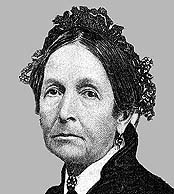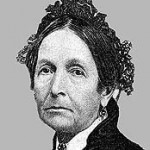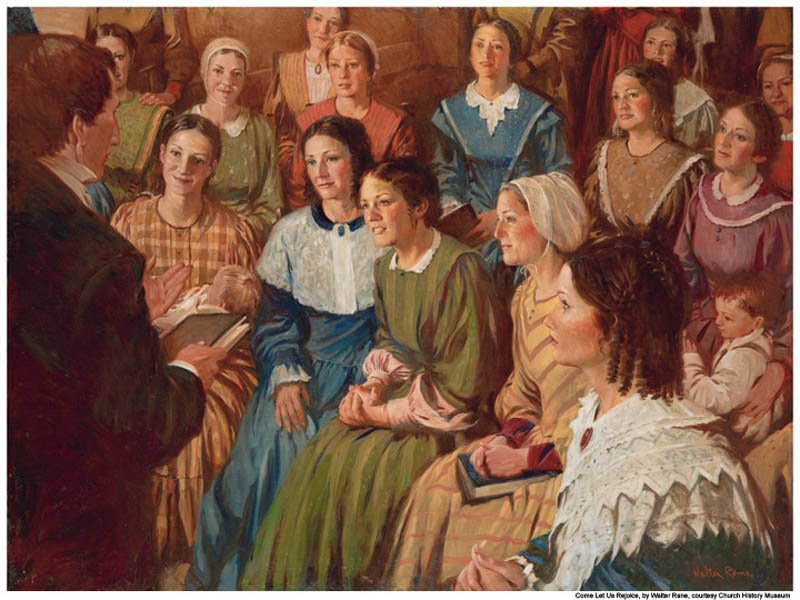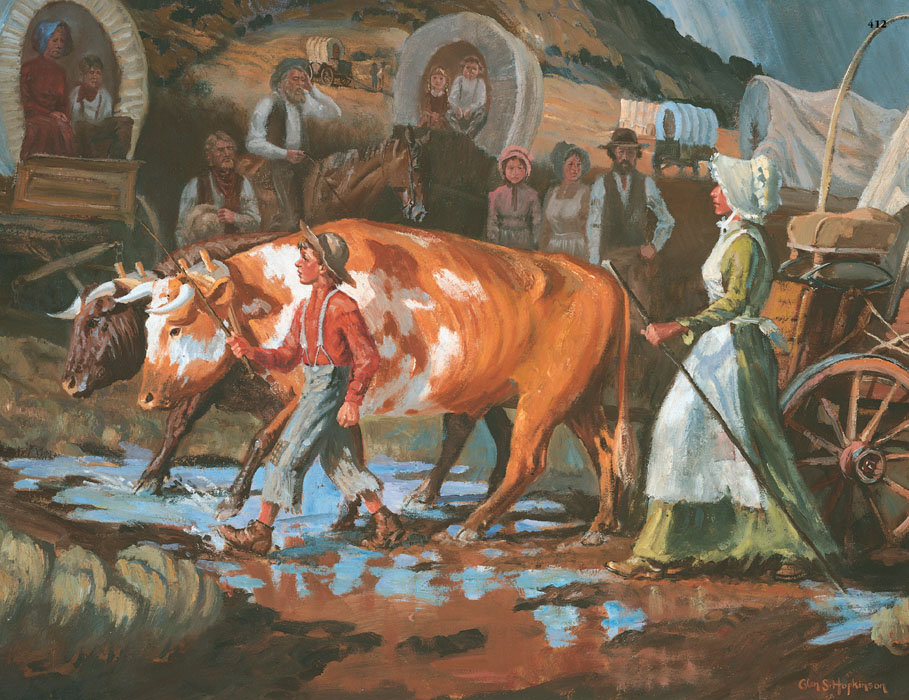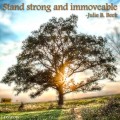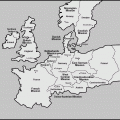Eliza R. Snow was a pioneer, an early president of the Relief Society (an organization for Mormon women), president of Deseret Hospital, president of the Women’s Department of the Endowment House, and an author. She is considered one of the great women in Mormon history.
While many people pictured Mormon pioneer women as meek and mild, no one ever accused Eliza of such. She repeatedly protested this mischaracterization. One month before the Utah legislature returned to Utah women the suffrage they had lost when they gained statehood, she said:
Our enemies pretend that, in Utah, woman is held in a state of vassalage—that she does not act from choice, but by coercion. What nonsense!
I will now ask of this assemblage of intelligent ladies, Do you know of any place on the face of the earth, where woman has more liberty and where she enjoys such high and glorious privileges as she does here as a Latter-day Saint? No! the very idea of a woman here in a state of slavery is a burlesque on good common sense … as women of God, filling high and responsible positions, performing sacred duties—women who stand not as dictators, but as counselors to their husbands, and who, in the purest, noblest sense of refined womanhood, are truly their helpmates—we not only speak because we have the right, but justice and humanity demands we should! (quoted in Jaynann Morgan Payne, “Eliza R. Snow: First Lady of the Pioneers,” Ensign, Sep 1973, 62
Stories of her feisty spirit are well-known. When Governor Boggs of Missouri ordered Mormons removed from his state and approved an extermination order, she confronted him boldly, in a way not common for women of her time. He told her this would cure her of her faith. She retorted that it would take a great deal more than this to do that. He was surprised and reportedly humbled by her response and said, “I must confess, you are a better soldier than I am.” Eliza was not honored by such a comment. Instead, she later said that unless he was a great deal better than the others of his type, it wasn’t much of a compliment.
When it came time to travel to new homes, Eliza went boldly on, once even learning to drive an ox-team. She knew how to handle horses, but found oxen a bit more challenging, although she was soon as skilled as any man. Newly arrived in Salt Lake City, she lived first in a small cabin which was covered by a roof made of willows and dirt. When it rained, the roof leaked. Even worse, it had housed mice nests and she found it was raining mice and mud into her home. Instead of crying or shrieking, she simply opened an umbrella and sat under it all night, laughing at what she saw as a funny situation.
Eliza R. Snow was born on January 21, 1804, in Becket, Massachusetts. Her parents became members of The Church of Jesus Christ of Latter-day Saints, whose members are often nicknamed Mormons, in the early days of the church, and four years later, Eliza converted in 1835 after her own personal prayers to find the truth were answered. Upon joining the church, she moved to Kirtland, Ohio, where the Mormons were gathered. She taught a school for young ladies because Joseph Smith was adamant that girls receive a good education. She soon convinced her brother Lorenzo to join her to study Hebrew under Joshua Seixas, but really to help him get to know Joseph Smith, whom Lorenzo had once heard speak. He soon joined the church and later became the president of the Mormons.
Although she received a number of proposals, she had remained single until this time. She was sealed (married for eternity) to Joseph Smith as a plural wife two years before he was murdered. She was later, after Joseph’s death, married as a plural wife to Brigham Young for time only, meaning it was not an eternal marriage. He respected her intelligence and leadership abilities and often turned to her for counsel and for important leadership responsibilities. It was believed she was married to him simply to ensure her well-being, but although it might not have been a traditional marriage relationship, she always sat on his right at the dinner table and at prayer, and Brigham turned to her regularly for her wisdom. Eliza never had children.
Eliza was a noted author and poet, well-known both in the church and in the outside world. Many of her poems were turned into songs. Some of the most popular LDS hymns were her work and she published many books of poetry in both religious and secular fields. She was particularly noted for her theological writing and for her patriotic writing. Descending from early American colonists and being the descendant of a Revolutionary War soldier, she was particularly interested in and knowledgeable about history and government. She found it quite possible to be fully patriotic while disagreeing with some government actions, such as those taken illegally against the Mormons.
One of her most important roles was in helping to create and then rebuild the Relief Society. When Mormon women decided they wanted to start their own humanitarian organization, modeled after those common in the world at the time for women, they approached Eliza and asked her to write a constitution for them, since she was an author. She worked hard at it and when it was presented to Joseph Smith for approval, he praised it, saying it was the best he’d ever seen. However, he said he had something better for them than a constitution. He proposed to organize the women of the church in the pattern of the priesthood, meaning their organization would be set up like the one for the men. While men needed the power of the priesthood to minister to others, he said, the women would be able to do it with faith alone, surely a great compliment to his view of what women are capable of.
The women organized and Joseph Smith’s wife Emma was named president. Eliza served as the secretary. Later, the organization was disbanded for a time, while the church was unsettled and constantly moving. The women continued to serve, of course, but informally. In 1866, with the Mormons settled in Utah under Brigham Young, the Relief Society was reorganized. Brigham Young asked Eliza to help the women in each ward (congregation) to set up the program properly. She wasn’t officially made the General Relief Society president for the entire church until 1880, but she certainly filled the role. She studied the notes she had kept as secretary of the Relief Society in Nauvoo, when it was first organized, to understand how it was supposed to work and used that to train new leaders. She assisted them in following Brigham Young’s counsel to become self-sufficient, encouraging women to store grain for emergencies, raise their own silk, and get medical training. To this end, women were sent to medical school at a time when this was rare and controversial and others were trained as nurses. By her death, Eliza had helped to organize more than 300 Relief Societies.
Eliza’s Relief Societies were powerful organizations. They did more than serve meals to the hungry and to care for the poor, the original goals of the women who first conceived of the program. Under Eliza’s direction, they provided medical school scholarships, worked for women’s suffrage (which Mormon women had until Utah became a state and the secular government removed it), ran both a hospital and a newspaper, and performed a range of political activism.
She also helped in organizing the Primary for children and the Retrenchment Associations for Young Women. Because of her leadership in all the organizations overseen by women, she was informally known as the “presidentess” as well as the Saints’ own poet.
Eliza had sometimes said she didn’t want to be famous or well-known, but she didn’t quite want to be forgotten either. Although she often wrote under pen names and did her work quietly, the challenges of the adult life she chose for herself thrust her into the limelight and she accepted it gracefully, always determined to put God before her own feelings and desires.
About Terrie Lynn Bittner
The late Terrie Lynn Bittner—beloved wife, mother, grandmother, and friend—was the author of two homeschooling books and numerous articles, including several that appeared in Latter-day Saint magazines. She became a member of the Church at the age of 17 and began sharing her faith online in 1992.

